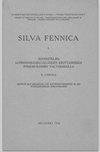Comprehensive yield model for plantation teak in Panama
IF 1.7
3区 农林科学
Q2 FORESTRY
引用次数: 9
Abstract
The purpose of this study was to prepare a comprehensive, computerized teak (Tectona grandis L.f) plantation yield model system that can be used to describe the forest dynamics, predict growth and yield and support forest planning and decision-making. Extensive individual tree and permanent sample plot data were used to develop tree-level volume models, taper curve models and stand-level yield models for teak plantations in Panama. Tree volume models were satisfactorily validated against independent measurement data and other published models. Tree height as input parameter improved the stem volume model marginally. Stand level yield models produced comparable harvest volumes with models published in the literature. Stand level volume product outputs were found like actual harvests with an exception that the models marginally underestimate the share of logs in very large diameter classes. The kind of comprehensive model developed in this study and implemented in an easy to use software package provides a very powerful decision support tool. Optimal forest management regimes can be found by simulating different planting densities, thinning regimes and final harvest ages. Forest practitioners can apply growth and yield models in the appropriate stand level inventory data and perform long term harvest scheduling at property level or even at an entire timberland portfolio level. Harvest schedules can be optimized using the applicable financial parameters (silviculture costs, harvesting costs, wood prices and discount rates) and constraints (market size and operational capacity).巴拿马人工林柚木综合产量模型
本研究的目的是建立一个全面的计算机化柚木人工林产量模型系统,用于描述森林动态、预测生长和产量,为森林规划和决策提供支持。利用大量的单株树和永久样地数据建立了巴拿马柚木人工林的树级体积模型、锥度曲线模型和林分级产量模型。根据独立的测量数据和其他已发表的模型,对树木体积模型进行了令人满意的验证。树高作为输入参数对茎体积模型有一定的改善。林分水平产量模型产生的收获量与文献中发表的模型相当。林分水平的体积产品输出与实际收获相似,除了模型略微低估了非常大直径类别中原木的份额。这种综合模型在本研究中开发并实现在一个易于使用的软件包提供了一个非常强大的决策支持工具。通过模拟不同的种植密度、间伐制度和最终采伐年龄,可以找到最优的森林管理制度。森林从业者可以将生长和产量模型应用于适当的林分水平清单数据,并在财产水平甚至整个林地组合水平上执行长期采伐计划。可以利用适用的财务参数(造林成本、采伐成本、木材价格和贴现率)和约束条件(市场规模和运营能力)优化采伐计划。
本文章由计算机程序翻译,如有差异,请以英文原文为准。
求助全文
约1分钟内获得全文
求助全文
来源期刊

Silva Fennica
农林科学-林学
CiteScore
3.50
自引率
11.10%
发文量
21
审稿时长
3 months
期刊介绍:
Silva Fennica publishes significant new knowledge on forest sciences. The scope covers research on forestry and forest ecosystems. Silva Fennica aims to increase understanding on forest ecosystems, and sustainable use and conservation of forest resources. Use of forest resources includes all aspects of forestry containing biomass-based and non-timber products, economic and social factors etc.
 求助内容:
求助内容: 应助结果提醒方式:
应助结果提醒方式:


